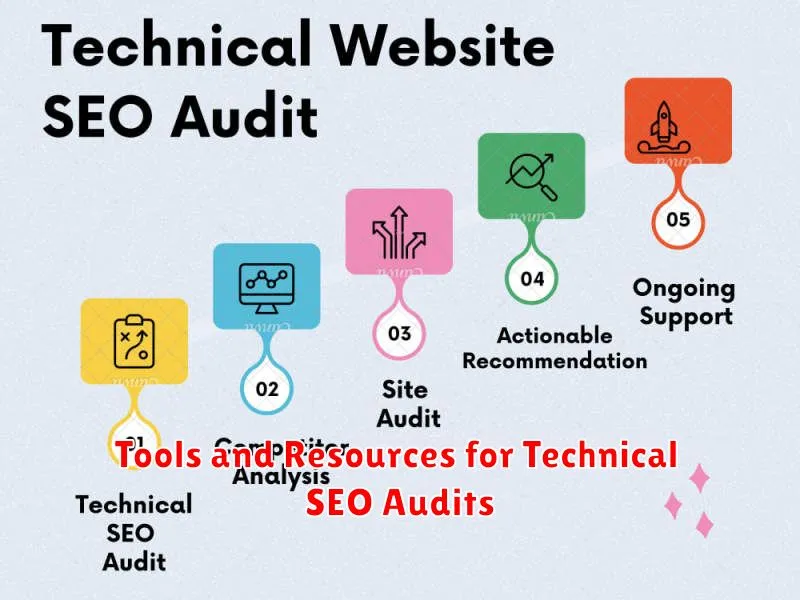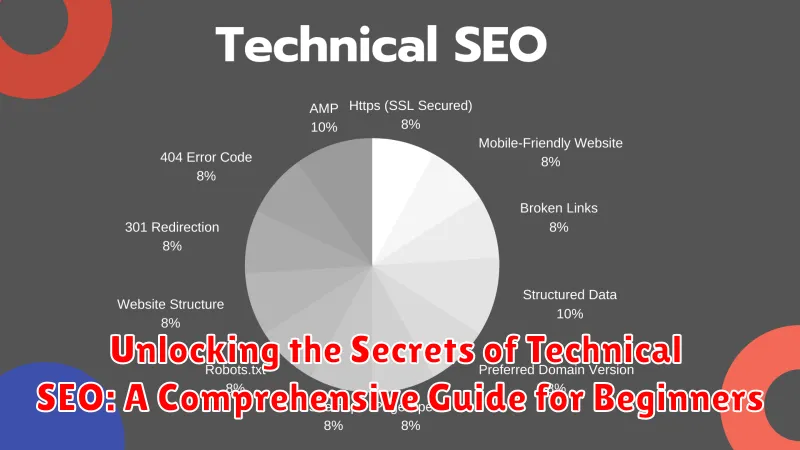In today’s digital landscape, having a visually appealing website isn’t enough. To truly thrive online, mastering Technical SEO is paramount. This comprehensive guide is designed specifically for beginners, demystifying the complexities of technical search engine optimization and providing you with the foundational knowledge to improve your website’s visibility, attract more organic traffic, and ultimately, achieve higher search engine rankings. From understanding the importance of crawlability and indexability to optimizing site speed and mobile-friendliness, this guide will unlock the secrets of Technical SEO and empower you to build a strong foundation for online success.
This comprehensive guide will delve into the core elements of Technical SEO, offering practical tips and actionable strategies. We will explore crucial aspects such as website architecture, structured data, XML sitemaps, and robots.txt. By the end of this guide, beginners will possess the knowledge and confidence to implement effective Technical SEO practices, optimizing their websites for search engines and establishing a solid online presence. Prepare to unlock the secrets and embark on your journey to Technical SEO mastery.
Understanding the Core Concepts of Technical SEO
Technical SEO forms the foundation of a successful online presence. It encompasses all the behind-the-scenes optimizations that make it easier for search engines to crawl, index, and understand your website. Ignoring these crucial elements can severely hinder your website’s visibility, regardless of how great your content is.
Crawlability refers to a search engine’s ability to access and navigate through your site. This involves ensuring search engine bots can easily discover and follow links within your website. Indexability, on the other hand, dictates whether a search engine chooses to include your web pages in its index. A page must be crawlable to be indexed, but crawlability doesn’t guarantee indexing. Factors like duplicate content or instructions to exclude pages can prevent indexing.
Rendering is the process where a search engine transforms your website’s code into the visual page users see. This includes processing HTML, CSS, and JavaScript to understand the layout and content of your site. Effective rendering is vital for search engines to accurately interpret the information presented on your pages.
The Importance of Website Speed and Performance
In the realm of technical SEO, website speed and performance play a critical role in determining your search engine rankings and overall user experience. Search engines like Google prioritize websites that load quickly, providing users with a seamless browsing experience.
A slow-loading website can lead to a higher bounce rate, meaning users are more likely to leave your site before exploring its content. This negative signal can impact your search rankings and ultimately affect your website’s visibility.
Core Web Vitals, a set of metrics focused on user experience, are now a significant ranking factor. These metrics measure aspects like largest contentful paint (LCP), first input delay (FID), and cumulative layout shift (CLS), all of which are directly related to website speed and stability.
Optimizing your website’s performance involves various techniques, such as minimizing HTTP requests, compressing images, leveraging browser caching, and utilizing a content delivery network (CDN). By addressing these technical aspects, you can significantly improve your website’s loading speed and provide a better experience for your users.
Optimizing Your Website for Mobile-First Indexing
With the rise of mobile browsing, Google has shifted to a mobile-first indexing approach. This means Google predominantly uses the mobile version of your website for indexing and ranking. Therefore, optimizing your site for mobile devices is crucial for SEO success.
Ensure your mobile site offers the same content as your desktop version. This includes text, images, and videos. Discrepancies can negatively impact your search rankings. Responsive design is a highly recommended approach for delivering a consistent experience across different devices. It allows your website to adapt seamlessly to various screen sizes.
Page speed is a critical factor for mobile optimization. Mobile users expect fast loading times. Optimize images, leverage browser caching, and minimize HTTP requests to improve performance. Use Google’s PageSpeed Insights tool to analyze your website’s speed and identify areas for improvement. Address any issues promptly to enhance the user experience and boost your search visibility.
Mastering the Art of Site Architecture and Navigation
A well-defined site architecture is crucial for both user experience and search engine crawlability. It dictates how your content is organized and how users and search engine bots navigate through your website.
A logical site structure, often visualized as a pyramid, starts with your homepage at the top. Key categories branch out from the homepage, followed by subcategories and individual pages. This hierarchical structure makes it easy for search engines to understand the context and relevance of your content.
Navigation plays a vital role in guiding users seamlessly through this structure. A clear and intuitive navigation menu allows users to easily find the information they need. Internal linking, using relevant anchor text, further strengthens the connections between your pages, assisting both users and search engines in discovering related content. A well-structured site architecture complemented by effective navigation enhances the overall discoverability of your website.
Consider using a sitemap to provide search engines with a comprehensive blueprint of your website structure. This allows search engines to quickly and efficiently crawl and index your content.
The Power of Structured Data and Schema Markup
Structured data and schema markup are essential aspects of technical SEO that enhance how search engines understand your content. By implementing structured data, you provide search engines with explicit clues about the meaning of your content, enabling them to present it more effectively in search results.
Schema markup is a vocabulary of tags that you add to your HTML to improve the way search engines understand and display your content. Think of it as a translator between your website and search engines.
Benefits of using structured data and schema:
- Enhanced search results: Schema markup can lead to rich snippets, which include additional information in search results, like ratings, reviews, and pricing. This improves visibility and click-through rates.
- Improved understanding: Search engines can better understand the context of your content, leading to more relevant search results.
- Voice search optimization: Structured data plays a vital role in voice search as it helps digital assistants provide accurate and concise answers.
By using structured data, you’re giving search engines the information they need to accurately represent your content, leading to a richer search experience for users and improved visibility for your website.
Technical SEO Best Practices for Crawlability and Indexability
Crawlability and indexability are foundational to technical SEO. Crawlability refers to search engines’ ability to access and navigate your website, while indexability determines whether those pages are added to their index for potential display in search results. Implementing best practices in these areas is crucial for organic visibility.
Optimize your robots.txt file. This file instructs search engine crawlers which pages or sections of your website should not be accessed. Ensure it doesn’t inadvertently block crucial content.
Create an XML sitemap. A sitemap acts as a roadmap for search engines, listing all important pages you want indexed. This makes it easier for them to discover and crawl your content.
Ensure proper use of HTTP status codes. Codes like 200 (OK) indicate a successfully loaded page. Incorrect codes, such as 404 (Not Found) or 500 (Internal Server Error), signal issues that need immediate attention.
Improve website speed. A fast-loading website enhances both user experience and crawlability. Optimize images, minimize HTTP requests, and leverage browser caching to boost performance.
Implement structured data. Using schema markup helps search engines understand the context of your content, improving its visibility and potential for rich results.
Common Technical SEO Mistakes to Avoid
Even with the best intentions, technical SEO mistakes can hinder your website’s performance. Avoiding these common pitfalls is crucial for achieving optimal search visibility.
Ignoring Crawl Errors
Regularly checking your website’s crawl errors in tools like Google Search Console is essential. Addressing these errors promptly ensures search engines can access and index your content effectively.
Slow Page Speed
A slow-loading website frustrates users and negatively impacts search rankings. Optimize images, leverage browser caching, and minimize HTTP requests to improve page speed.
Duplicate Content
Duplicate content confuses search engines and dilutes your website’s authority. Implement canonical tags to specify the preferred version of a page and avoid unintentional duplication.
Incorrect Use of Robots.txt
Accidentally blocking crucial sections of your website with robots.txt can prevent search engines from indexing important content. Carefully review and test your robots.txt file to ensure proper configuration.
Missing or Incorrect XML Sitemaps
XML sitemaps help search engines discover and understand the structure of your website. Ensure your sitemap is accurate, up-to-date, and submitted to search consoles.
Measuring and Analyzing Your Technical SEO Performance
Measuring and analyzing your technical SEO performance is crucial to understanding the effectiveness of your optimization efforts. This involves tracking key metrics and identifying areas for improvement.
Start by monitoring your crawl stats within your preferred search console. Look for any crawl errors, spikes in 404 errors, or unusually long crawl times. These issues can indicate problems with your site’s structure or server configuration.
Next, analyze your site’s index coverage. Ensure Google has indexed the pages you want visible in search results and identify any unintentional indexing of pages like staging or test environments. Address any discrepancies promptly.
Page speed is another vital metric. Tools like PageSpeed Insights offer valuable data about your site’s loading performance and highlight areas for optimization. A faster site generally leads to a better user experience and improved rankings.
Regularly review your robots.txt file and XML sitemap submissions to ensure they are accurate and up-to-date. These tools guide search engines through your site, so it’s critical they are functioning correctly.
Future Trends in Technical SEO

The field of technical SEO is constantly evolving. Staying ahead of the curve requires awareness of emerging trends. Artificial intelligence is playing an increasingly significant role, impacting areas like content optimization and search pattern analysis. Expect more sophisticated AI-driven tools to emerge.
Core Web Vitals and user experience will continue to be crucial ranking factors. Optimizing for a seamless user experience across all devices will become even more critical. This includes prioritizing mobile-first indexing and page speed.
Semantic SEO is another key area to watch. Search engines are getting better at understanding the context and meaning behind content. Structured data markup and focusing on topic clusters will help search engines comprehend your website’s structure and content more effectively.
Finally, the increasing importance of JavaScript SEO must be addressed. Websites heavily reliant on JavaScript need to ensure proper rendering and indexing for search engine crawlers. Implementing server-side rendering or dynamic rendering solutions may become increasingly necessary.
Tools and Resources for Technical SEO Audits

Conducting regular technical SEO audits is crucial for maintaining and improving your website’s performance. Thankfully, several powerful tools and resources can assist in this process. Utilizing these resources can help identify and address technical issues effectively.
Popular SEO Auditing Tools
Several comprehensive SEO platforms offer auditing capabilities. These tools often provide a range of features including site crawling, backlink analysis, and keyword research, in addition to technical SEO auditing. Some popular options include Semrush, Ahrefs, and Moz.
Specialized Technical SEO Tools
For a more focused approach to technical SEO, specialized tools like Screaming Frog and DeepCrawl offer in-depth website crawling and analysis. These tools provide detailed reports on various technical aspects, including broken links, redirect chains, and indexing issues.
Free Tools and Resources
Google Search Console is an invaluable free resource provided by Google. It offers crucial data on how Google sees your website, highlighting indexing errors, mobile usability problems, and other critical technical issues. Google’s PageSpeed Insights is another useful free tool that analyzes your website’s loading speed and provides recommendations for improvement.

